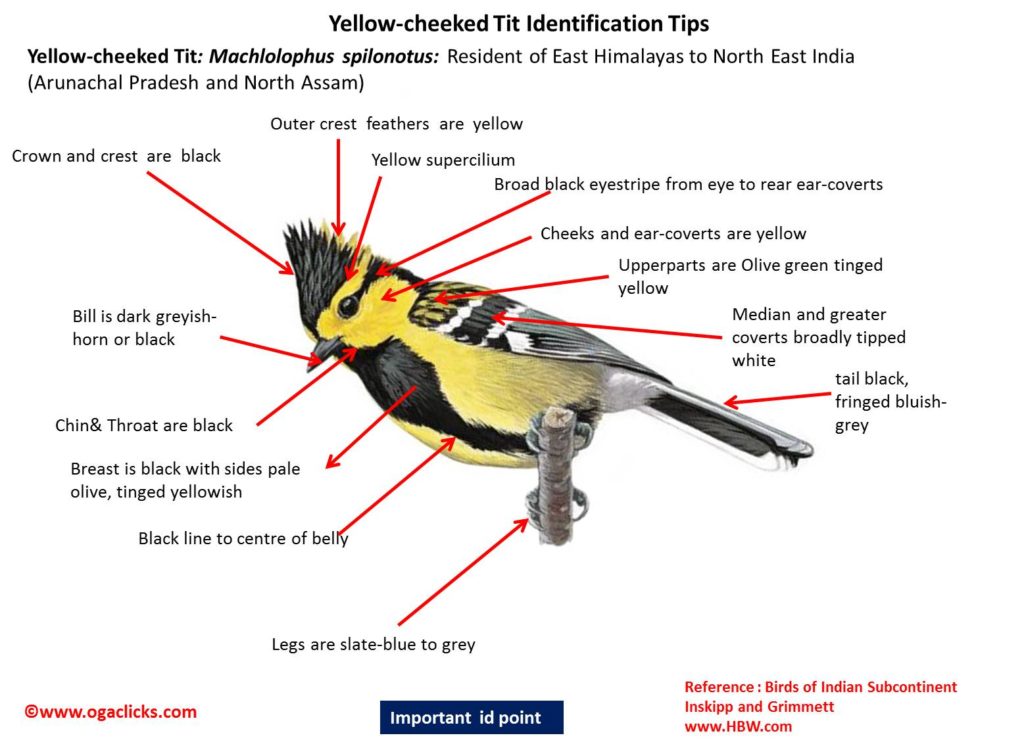Yellow-cheeked Tit

Yellow-cheeked Tit Machlolophus spilonotus
Etymology:
- Machlolophus : Greek word makhlos – luxuriant; lophos –
- Spilonotus : Greek word spilos- spot; notos-backed
Distribution in India: Resident of Eastern Himalayas and North Eastern Hills in India.
Description:
Size of13·5–15·5 cm; wt. of 18–23 g. It is medium-sized to large size tit with erect black crest and eyestripe and yellow cheeks. The male nominate race has yellow forehead and lores to supercilium and nuchal spot. The crown and crest to side of nape is black, yellow nape extending upwards onto tips of longest crest feathers; broad black eyestripe from eye to rear ear-coverts; upperparts are olive-green, tinged yellow, with blackish centers of mantle. Its back and scapular feathers and rump are slightly greyish. The tail is black, fringed bluish-grey, all feathers narrowly tipped white, outer web of outermost feather is white. The upperwing-covertsis black, median and greater coverts are broadly tipped white, alula is finely tipped white. The flight-feathers are blackish-grey, tertials narrowly fringed pale grey and broadly tipped white. The secondaries and primaries are fringed bluish-grey, outer primaries broadly white at base. The cheeks, ear-coverts and side of neck are yellow. The chin, throat to center of breast and continuing in irregular line to center of bellyis black. It is slightly glossed blue on throat and breast; sides of breast and belly are pale olive, tinged yellowish, flanks the same or greyish-olive, undertail-coverts dark grey, tipped whitish. The underwing-coverts are blackish, broadly tipped white. In worn plumage, the upperparts are duller or greyer and dark centers of mantle and scapulars are larger, fringes of flight-feathers are reduced, white tips of tail are abraded, ventral line slightly broader, rest of underparts paler. The iris is brown; bill is dark greyish-horn or black; legs are slate-blue to grey. The female differs from male in having wingbars yellowish-white, fringes of flight-feathers olive and bib slightly duller. The juvenile is as adult, but crown is duller, crest is shorter, face and nuchal patch are paler, upperparts are duller, becoming greyer on rump and uppertail-coverts, whitish tail tips are poorly defined , upperwing-coverts are as adult but duller and tipped yellowish, secondaries are fringed grey and tertials fringed olive-grey, cheeks and ear-coverts are pale yellow, small dull brownish-black ,bib to center of breast and ventral line to center of belly, rest of underparts are pale yellow, greyish wash on flanks. . The nominate race is found in Arunachal Pradesh and North Assam; race subviridis (South Assam to Manipur) is as nominate, has darker olive upperparts, dark centers showing as scales, tips of upperwing-coverts are white or washed yellowish, neck side and underparts are slightly duller or paler, flanks are washed greyish-olive, female has more uniform and less scaled mantle, flight-feather edges are light olive, bib and ventral stripe are olive-yellow or absent .
Habitat: It is found in open temperate and subtropical deciduous or mixed forests with oak , pine and rhododendron, secondary forest, bamboo, edges of cultivation, including plantations and areas with scattered trees. It breeds from 1200m to 3000m. In non-breeding season it comes down to lower levels 350m-700 m
Food habits: It eats small invertebrates and larvae, buds and some fruit. It is found usually in pairs or small family parties. In non-breeding season found in mixed-species foraging flocks with other tits and small babblers. It actively forages in middle and lower levels of forest trees, also in shrubs and undergrowth.
Breeding habits: They breeds in Feb to Aug. The nest is a small platform or pad of moss, grass, bracken strips, leaves, animal fur, wool and feathers, sometimes supplemented with other locally available items like,flower petals and snakeskin. The nest is placed up above ground in hole in tree, in hole in wall or rocky bank. They lay a clutch of 4–6 eggs.